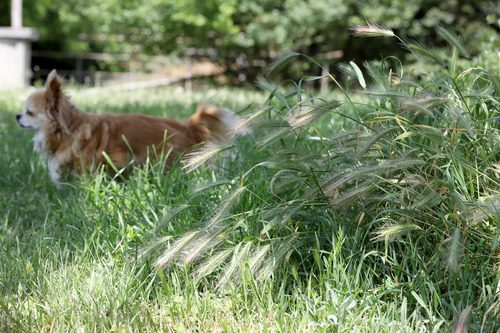Foxtails and dogs can be a dangerous combination. These seemingly harmless plants can pose serious health risks to your canine companion. At Live Oak Veterinary Hospital in Sonora, CA, we want to ensure your pet’s safety and well-being by educating you on the dangers of foxtails and how to protect your dog. If you have concerns about foxtails and dogs, call us at 209-432-9437 or book an appointment online.

What Are Foxtails?
Foxtails are grass-like weeds that can be found in many parts of California and throughout the United States. The plant produces seed heads that resemble a fox’s tail, hence the name. These seed heads are designed to burrow into the ground to germinate, but they can also burrow into your dog’s skin, ears, nose, and other body parts. The barbed shape of the seed heads allows them to move in one direction, making it difficult for them to dislodge naturally once embedded.
How Foxtails Affect Dogs
Foxtails can cause a range of health issues for dogs. When these barbed seeds come into contact with your dog’s skin, they can embed themselves and migrate deeper into the body, potentially causing infections, abscesses, and more severe complications. Let’s explore the eight reasons why foxtails are dangerous for dogs.
1. Skin Irritation and Infections
Foxtails can easily get caught in your dog’s fur and penetrate the skin. Once under the skin, they can cause irritation, redness, and swelling. If not removed promptly, foxtails can lead to painful infections that may require medical treatment.
2. Ear Problems
Foxtails can enter your dog’s ears, leading to discomfort and serious ear infections. Signs that your dog may have a foxtail in their ear include excessive scratching, head shaking, and ear discharge. Ear infections caused by foxtails can be painful and may require veterinary intervention.
3. Nasal Complications
If a foxtail enters your dog’s nose, it can cause sneezing, nasal discharge, and even bleeding. Foxtails can travel through the nasal passages, leading to severe respiratory issues. Dogs with foxtails in their noses often paw at their faces and show signs of distress.
4. Eye Injuries
Foxtails can also affect your dog’s eyes. If a foxtail gets into the eye, it can cause irritation, redness, and excessive tearing. In severe cases, foxtails can lead to corneal ulcers and other serious eye conditions that may require immediate veterinary care.
5. Paw Infections
Dogs often pick up foxtails in their paws while walking or playing outside. Foxtails can become embedded between the toes or in the paw pads, causing pain and infection. You may notice your dog licking or chewing their paws excessively if a foxtail is present.
6. Lung and Internal Damage
In rare cases, foxtails can migrate through your dog’s body and reach internal organs. Foxtails in the lungs can cause severe respiratory issues, while those that reach other internal organs can lead to life-threatening conditions. This is why it’s crucial to address foxtail issues promptly and seek veterinary care if you suspect your dog has been affected.
7. Genital and Urinary Tract Issues
Foxtails can also find their way into your dog’s genital area, causing significant discomfort and potential infections. Female dogs are particularly at risk, as foxtails can enter the vulva and migrate into the urinary tract, leading to urinary infections and other complications.
8. General Discomfort and Behavioral Changes
Dogs suffering from foxtail-related issues often exhibit changes in behavior due to pain and discomfort. They may become lethargic, lose their appetite, or show signs of distress. Observing these behavioral changes and seeking veterinary care promptly can help prevent further complications.
Preventing Foxtail Injuries in Dogs
Preventing foxtail injuries involves taking proactive steps to protect your dog from these dangerous plants. Here are some tips to help you keep your dog safe:
- Regular Grooming: Regular grooming can help reduce the risk of foxtail injuries. Brush your dog’s fur frequently to remove any foxtails that may be caught. Pay special attention to areas with long hair, such as the paws, ears, and belly.
- Avoiding Foxtail-Infested Areas: When walking your dog, try to avoid areas known to have foxtails, especially during the peak season. Stick to well-maintained paths and parks where foxtails are less likely to be present.
- Using Protective Gear: Consider using protective gear, such as booties and vests, to minimize your dog’s exposure to foxtails. These items can help prevent foxtails from becoming embedded in your dog’s fur and skin.
How Live Oak Veterinary Hospital Can Help
Foxtails and dogs do not mix well. Understanding the risks and taking preventative measures can help protect your dog from the dangers of foxtails. If you suspect that your dog has been affected by foxtails, it is essential to seek veterinary care promptly. Early intervention can prevent serious complications and ensure your dog’s health and comfort. At Live Oak Veterinary Hospital, we are here to help you with any foxtail-related concerns. Call us at 209-432-9437 or book an appointment online to get your dog the care they need.
